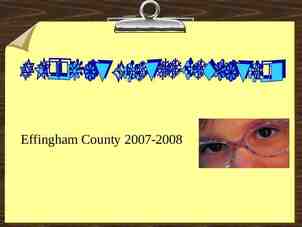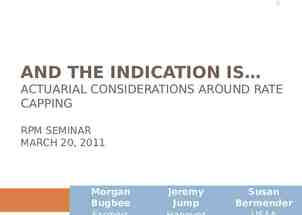Math 340L – CS What’s this all about?
55 Slides894.51 KB
Math 340L - CS What’s this all about?
What Shall We Do Today?
What Shall We Do Today? Option 1: Get an Introduction to the course.
What Shall We Do Today? Option 2: Sing some of your favorite campfire songs.
Important Stuff Course: Math 340LMatrices and Matrix Calculations Time: T-TH 9:30-11:00 in WAG 201 Instructor: A. K. Cline Office: GDH 5.808 Office Hours: Tu 11-12, W 11-12, F 1-2, and by appointment Web Site: http://www.cs.utexas.edu/users/cline/M340L/ Email: [email protected] Assistant: Jillian Fisher Office: TBD Office Hours: TBD Email: [email protected]
Text and Video Lectures Text: Linear Algebra and its Applications, 4th or 5th ed., by David C. Lay. Gilbert Strang’s lectures based upon his book may be found at http://ocw.mit.edu/courses/mathematics/18-06linear-algebra-spring-2010/
Comments 1. Good homework cannot make up for poor exams nor good exams for poor homework. To do well in the course grade, students must have good homework and exams. 2. There will be approximately one set of homework problems assigned each week. These will be submitted electronically due at 9:30, the beginning of the following class. Solutions for each problem set will be distributed. 3. An excellent summary of expectations is found at http://www.cs.utexas.edu/users/ear/CodeOfConduct.html
Homework Specifications 1. Your solutions must be legible. If your writing is not legible, use a word processor. 2. Every sentence - even those using mathematical notation - must be readable. There must be clear subjects and verbs - not just random phrases. 3. Criticize your own solutions. You should be learning not only how to create solutions but how to recognize correct ones. If you wonder about having too much or too little detail, err always on the side of too much detail. 4. If you realize that your solution has gaps or errors, admit that. Put comments about such omissions or possible errors in boxes. 5. Test your computations whenever possible.
Tutoring Sessions Every Monday evening from 6 to 8 PM, there will be a session in GDC 2.502 to answer questions. The questions may arise from homework assignments or otherwise. Please realize this will not be a repeat of lectures. The TA and a tutor will be present to respond to questions. More fundamental assistance should be obtained from the TA or me.
Grading Exam 1: 20% Exam 2: 20% Final Exam: 45% Homework: 15%
New Stuff for You No dedicated TA – we share
New Stuff for You No dedicated TA – we share Undergraduate grader
New Stuff for You No dedicated TA – we share Undergraduate grader Electronic submission of homework
New Stuff for You No dedicated TA – we share Undergraduate grader Electronic submission of homework Tutoring sessions
Topics: 1. Introduction to Vectors 1.1. Vectors and Linear Combinations 1.2. Lengths and Dot Products 1.3. Matrices 4. Orthogonality 4.1. Orthogonality of the Four Subspaces 4.2. Projections 4.3. Least Squares Approximations 4.4. Orthogonal Bases and Gram-Schmidt 2. Solving Linear Equations 2.1. Vectors and Linear Equations 2.2. The Idea of Elimination 2.3. Elimination Using Matrices 2.4. Rules for Matrix Operations 2.5. Inverse Matrices 2.6. Elimination Factorization: A LU 2.7. Transposes and Permutations 5. Determinants 5.1. The Area Property 3. Vector Spaces and Subspaces 3.1. Spaces of Vectors 3.2. The Nullspace of A: Solving Ax 0 3.3. The Rank and the Row Reduced Form 3.4. The Complete Solution to Ax b 3.5. Independence, Basis and Dimension 6. Eigenvalues and Eigenvectors 6.1. Introduction to Eigenvalues 6.2. Diagonalizing a Matrix 6.3. Similar Matrices 6.4. Applications 7. Linear Transformations 7.1. The Idea of a Linear Transformation 7.2. The Matrix of a Linear Transformation 7.3. Examples on Rn :rotations, projections, shears, and reflections
How long does it take for this code to run?
After examining the code you believe that the running time depends entirely upon some input parameter n and
After examining the code you believe that the running time depends entirely upon some input parameter n and a good model for the running time is Time(n) a b·log2(n) c·n d·n·log2(n) where a, b, c, and d are constants but currently unknown.
So you time the code for 4 values of n, namely n 10, 100, 500, and 1000 and you get the times Time(10) 0.685 ms. Time(100) 7.247ms. Time(500) 38.511ms. Time(1000) 79.134 ms.
So you time the code for 4 values of n, namely n 10, 100, 500, and 1000 and you get the times Time(10) 0.685 ms. Time(100) 7.247ms. Time(500) 38.511ms. Time(1000) 79.134 ms. According to the model you then have 4 equations in the 4 unknowns a, b, c, and d: a b·log2(10) c·10 d·10·log2(10) 0.685 a b·log2(100) c·100 d·100·log2(100) 7.247 a b·log2(500) c·5000 d·500·log2(500) 38.511 a b·log2(1000) c·1000 d·1000·log2(1000) 79.134
These equations are linear in the unknowns a, b, c, and d. a b·log2(10) c·10 d·10·log2(10) 0.685 a b·log2(100) c·100 d·100·log2(100) 7.247 a b·log2(500) c·5000 d·500·log2(500) 38.511 a b·log2(1000) c·1000 d·1000·log2(1000) 79.134
These equations are linear in the unknowns a, b, c, and d. a b·log2(10) c·10 d·10·log2(10) 0.685 a b·log2(100) c·100 d·100·log2(100) 7.247 a b·log2(500) c·5000 d·500·log2(500) 38.511 a b·log2(1000) c·1000 d·1000·log2(1000) 79.134 We solve them and obtain: a 6.5 b 10.3 c 57.1 d 2.2 So the final model for the running time is Time(n) 6.5 10.3·log2(n) 57.1·n 2.2·n·log2(n)
These equations are linear in the unknowns a, b, c, and d. a b·log2(10) c·10 d·10·log2(10) 0.685 a b·log2(100) c·100 d·100·log2(100) 7.247 a b·log2(500) c·5000 d·500·log2(500) 38.511 a b·log2(1000) c·1000 d·1000·log2(1000) 79.134 We solve them and obtain: a 6.5 b 10.3 c 57.1 d 2.2 So the final model for the running time is Time(n) 6.5 10.3·log2(n) 57.1·n 2.2·n·log2(n)
and now we may apply the model Time(n) 6.5 10.3·log2(n) 57.1·n 2.2·n·log2(n) for a particular value of n (for example, n 10,000) to estimate a running time of Time(10,000) 6.5 10.3·log2(10,000) 57.1· 10,000 2.2· 10,000 ·log2(10,000) 863.47 ms.
What’s a “good” solution when we don’t have the exact solution?
What’s a “good” solution when we don’t have the exact solution? “Hey. That’s not a question that was discussed in other math classes.”
What’s a “good” solution when we don’t have the exact solution? Consider the two equations: .780 𝑥 .563 𝑦 .217 .913 𝑥 .659 𝑦 .254
Consider two approximate solution pairs: 𝑥 1 ¿ .999 𝑦 1 ¿ 1.001 𝑥 2 ¿ .341 𝑦 2 ¿ 0.087 and these two equations: .780 𝑥 .563 𝑦 .217 .913 𝑥 .659 𝑦 .254
Consider two approximate solution pairs: 𝑥 1 ¿ .999 𝑦 1 ¿ 1.001 𝑥 2 ¿ .341 𝑦 2 ¿ 0.087 and these two equations: .780 𝑥 .563 𝑦 .217 .913 𝑥 .659 𝑦 .254 Which pair of these two is better?
Important fact to consider: 𝑥 1 ¿ .999 𝑦 1 ¿ 1.001 𝑥 2 ¿ .341 𝑦 2 ¿ 0.087 The exact solution is: 𝑥 1 𝑦 1 Which pair of these two is better?
Consider two approximate solution pairs: 𝑥 1 ¿ .999 𝑦 1 ¿ 1.001 𝑥 2 ¿ .341 𝑦 2 ¿ 0.087 and these two equations: .780 𝑥 .563 𝑦 .217 .913 𝑥 .659 𝑦 .254 Which pair of these two is better?
Important fact to consider: 𝑥 1 ¿ .999 𝑦 1 ¿ 1.001 Recall we are trying to solve: 𝑥 2 ¿ .341 𝑦 2 ¿ 0.087 .780 𝑥 .563 𝑦 .217 For the first pair, we have: .913 𝑥 .659 𝑦 .254 .780 𝑥 1 .563 𝑦 1 .215757 For the second pair, we have: .913 𝑥 1 .659 𝑦 1 .25 2428 .780 𝑥 2 .563 𝑦 2 .21 699 9 𝑥two 2 .659 Which pair.913 of these is better?𝑦 2 .254
Important fact to consider: 𝑥 1 ¿ .999 𝑦 1 ¿ 1.001 𝑥 2 ¿ .341 𝑦 2 ¿ 0.087 Which pair of these two is better?
Student: “Is there something funny about that problem?”
Student: “Is there something funny about that problem?” CLINE Professor: “You bet your life. It looks innocent but it is very strange. The problem is knowing when you have a strange case on your hands.”
CLINE Professor: “Geometrically, solving equations is like finding the intersections of lines.”
When lines have no thickness here’s the intersection?
but when lines have thickness where’s the intersection?
Galveston Island 25.96 miles
Galveston Island 25.96 miles Where’s the intersection?
London Olympics Swimming http://www.youtube.com/watch?v fFiV4ymE DfY&feature related 1:19
How do you transform this image
How do you transform this image into the coordinate system of another image?
and in greater generality, transform 3-dimensional objects
The 25 Billion Eigenvector How does Google do Pagerank?
The Imaginary Web Surfer: Starts at any page, Randomly goes to a page linked from the current page, Randomly goes to any web page from a dangling page, except sometimes (e.g. 15% of the time) go to a purely random page.
[U,G] surfer (‘http://www/utexas.edu, 500) 0 50 100 150 200 250 300 350 400 450 500 0 50 100 150 200 250 300 350 400 450 500
[U,G] surfer (‘http://www/utexas.edu, 100) 0 10 20 30 40 50 60 70 80 90 100 0 10 20 30 40 50 60 70 80 90 100
pagerank (U, G) Page Rank 0.25 0.2 0.15 0.1 0.05 0 0 20 40 60 80 100 120
x pagerank (U, G) [Y,I] sort (x, 1, ‘descend’) U(I) 'http://www.utexas.edu' 'http://www.utexas.edu/emergency' 'http://www.utexas.edu/maps' 'http://www.lib.utexas.edu' 'http://m.utexas.edu' 'http://healthyhorns.utexas.edu' 'http://www.utexas.edu/parking/transportation/shuttle' 'http://www.utexas.edu/know/feed' 'http://www.utexas.edu/know' 'http://www.texasexes.org/uthistory' 'http://www.utexas.edu/news' 'http://www.lib.utexas.edu/maps' 'http://youtu.be/itO9IXiH4Nk' 'http://www.engr.utexas.edu'
How much storage to hold this array?
How much storage to hold this array? Current estimate of indexed WWW: 4.7 · 1010 web pages
How much storage to hold this array? Current estimate of indexed WWW: 4.7 · 1010 web pages If placed into an array this would have 2.21 · 1021 elements
How much storage to hold this array? Current estimate of indexed WWW: 4.7 · 1010 web pages If placed into an array this would have 2.21 · 1021 elements If each element is stored in 4 bytes, this would be 8.8 · 1022 bytes
How much storage to hold this array? Current estimate of indexed WWW: 4.7 · 1010 web pages If placed into an array this would have 2.21 · 1021 elements If each element is stored in 4 bytes, this would be 8.8 · 1022 bytes Feb. 2011 estimate of world’s data storage capacity is 3.0 · 1020 bytes (.3% of necessary space) http://www.smartplanet.com/blog/thinking-tech/what-is-the-worlds-data-storage-capacity/6256




























































